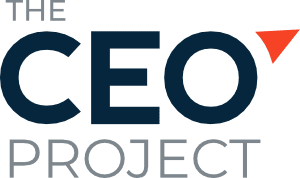Building the appropriate leadership team is among the most crucial early Steps for each scalable business. According to research, 86% of business leaders believe leadership is critical for business success. However, creating a leadership team that delivers growth and can adapt and evolve as the company scales is challenging for most companies.
In this blog post, we at The CEO Project will guide you through the strategic process of creating a leadership team that evolves with your business. We’ll touch on all the key elements—from bringing on the right talent to building a culture of accountability—you need to ensure your leadership team is primed to lead through growth.
Whether you’re starting to build a leadership team or want to elevate the one you have, this article’s tips will help you create a team that generates long-term success.

Why Building the Right Leadership Team Matters
Developing a leadership team that scales with your business is a necessity. A strong leadership team can offer purposeful direction to your company, driving expansion, innovation, and operational excellence. Conversely, an ineffective leadership team can stifle growth, slow down decision-making, and make the organization an operational mess.
Operational vs. Transformational Leaders – Traits & Impact
| Trait | Operational Leaders | Transformational Leaders |
|---|---|---|
| Focus | Day-to-day operations | Big-picture vision and strategy |
| Leadership Style | Task-oriented | People-oriented, inspiring change |
| Decision-Making | Process-driven | Value-driven, long-term impact |
| Impact on Growth | Efficiency | Innovation, scalability |
| Communication | Clear, concise | Inspires and motivates |
As the table indicates, operational leaders are generally concerned with running the organization daily. Transformational leaders tend to lead the way in innovation, inspiring teams, and aligning future growth strategies.
Defining the Qualities of Growth-Ready Leaders
When your business starts to grow, the attributes of your leadership team will be even more critical. Growth-ready leaders must navigate a constantly evolving business environment, make decisions that serve long-term goals, and successfully lead people.
To that end, here are the key characteristics defining growth-ready leaders.
- High Learning Agility
- Strategic Thinking
- Strong Communication & Collaboration Skills
- Cultural Alignment
- Accountability and Ownership Mindset
1. High Learning Agility
These leaders are highly agile learners and adapt rapidly to new challenges. They take in new information, adjust their actions, and deal well with uncertainty.
- Learning from mistakes and successes
- Embracing uncertainty and incontinual flux
- Adapt quickly to changing market demand
2. Strategic Thinking
Growth means stepping outside the daily operations and grasping the future. Growth-ready leaders know where to find opportunities and, more importantly, how to think strategically about moving the company forward.
- Do not let yourself focus on short-term victories but relatively long-term goals.
- Ability to analyze complex data and market trends
- Skilled at identifying gaps and opportunities in the business
3. Strong Communication & Collaboration Skills
Good communication and collaboration are keys to scaling businesses. Leaders must communicate their vision effectively, collaborate with other departments, and promote cross-team collaboration.
- Ability to communicate clearly and persuasively
- Good at conflict resolution and the ability to create a collaborative environment
- Experience in guiding cross-competency groups
4. Cultural Alignment
An excellent executive team needs to fit into your company’s culture. Effective leaders who recognize and embrace your culture will help reinforce your company’s values and create a culture that keeps everyone involved.
- Demonstrates and advocates company values
- Promotes inclusive and positive work environments
- Adapts leadership style to company culture
5. Accountability and Ownership Mindset
Leaders are held accountable for reaching targets and own the results (good and bad). This is a growth-oriented mindset that helps leaders drive towards fulfilling their commitments and consistently meeting target goals.
- Takes responsibility for results, both successes and failures
- Upholds a substantial standard of integrity and ethics
- Encourages a culture of accountability throughout the business
Hiring Leaders with Scalability in Mind
Hiring for growth isn’t only about filling empty seats—it is about proactively constructing a leadership team that can grow with your company. When your business starts to expand or scale, you realize that running an organization needs more than basic leadership skills. You want leaders capable of dealing with challenges, adapting to changing demands, and moving the business forward.
Here’s how you can hire with scalability in mind:
- Look Beyond the Resume
- Assess Leadership Potential
- Consider Future Needs
1. Look Beyond the Resume
A candidate’s qualifications and experience are essential but shouldn’t be the only variables influencing your decision. It’s crucial to seek leaders with proven experience and skills in managing growth and dealing with greater complexity.
- Experience with Growth and Scaling: Look for individuals who have experience steering businesses of the same size or similar stages of growth. These leaders are more likely to internalize your company’s challenges as it scales up. For instance, according to LinkedIn’s Global Talent Trends report, leaders with scaling experience are 30% more likely to roll out successful growth strategies than their counterparts without this experience.
- Proven Track Record of Driving Results: Look for candidates with a proven track record of leading change and delivering results instead of just hunting for someone who matches a specific job title or industry. This could be demonstrated through growth in revenue, successful team restructuring, or expansion into new markets.
2. Assess Leadership Potential
Great employees are not necessarily great leaders. When your company scales, you need more firepower to inspire teams to follow you.
- Ability to Motivate and Inspire Teams: Organizations need leaders who can motivate and inspire teams during growth periods. According to Gallup’s State of the American Workplace Report, Leadership teams that are highly engaged outperform their competitors by 21% in profitability and 17% in productivity.
- Strategic Thinking and Adaptability: Your leadership team must think strategically and be adaptable as the business landscape evolves. Hire leaders who recognize new opportunities, change course when needed, and successfully lead during change. According to research conducted by McKinsey & Company, organizations with solid strategic leadership capabilities grow 2.5 times faster than organizations lacking this capability.
- Emotional Intelligence: Leaders with high emotional intelligence (EQ) effectively navigate the strains of rapid growth and manage team dynamics. According to a study conducted by TalentSmart, EQ accounts for 58% of performance in all jobs, and top leaders have a high EQ.
3. Consider Future Needs
The leadership team’s needs will change as your company grows. Onboarding for future needs means hiring leaders who can meet the challenges of rapidly scaling.
- Anticipating the Skills You’ll Need: Plan for the Future 2-5 years about what skills and capabilities your business’s leadership team will need? For instance, if your company is expanding globally, you may want leaders who have experience in global operations or cross-cultural management. According to a study conducted by PwC, 48% of CEOs said they want global expansion over the next 2-3 years, which means hiring internationally aware leaders is critical.
- Building a Diverse Leadership Pipeline: Diversity is the future of leadership. According to McKinsey’s Diversity wins report, companies in the top quartile for ethnic diversity are 36% more likely to have above-average profitability than companies in the bottom quartile. As you look forward to future needs, ask yourself how your leadership team will need to evolve to adapt to the demands of a diverse, global marketplace.

Developing & Evolving Your Existing Leadership Team
The leadership team can never be static—it must change as your company does. It’s not enough to hire the right people in the first place; your existing leadership team has to develop and grow to meet new challenges and growth opportunities.
- Conduct Regular Capability Assessments
- Provide Ongoing Development Opportunities
- Promote From Within (When Possible)
1.Conduct Regular Capability Assessments
As your business grows, you need to continuously evaluate the skills of your leadership team to ensure they stay aligned with the company’s evolving demands. These evaluations will show strengths and areas for improvement.
- Perform a 360-degree review every year.
- Assess the success and alignment of leadership with the business objectives.
- Take note of skills or leadership capability gaps.
2. Provide Ongoing Development Opportunities
It is vital to invest in the development of your leadership team. Offer executive coaches, leadership development programs, and ongoing training to help them stay ahead of the industry trends and improve their skills.
- Provide leadership training and executive coaching.
- Encourage opportunities for organization and individual cross-functional learning.
- Encourage participation in industry conferences and events.
3. Promote From Within (When Possible)
Promoting from within creates loyalty and ensures leaders already embody your company culture. Where possible, promote internally to fill leadership roles as the company grows.
- Identify high-potential employees and give them leadership development opportunities.
- Provide mentoring and career progression opportunities for new leaders.
- Build a leadership pipeline in the organization.
Creating a Leadership Culture of Trust & Accountability
The leadership culture of a high-growth company must be built on trust, transparency, and accountability.
Here’s how to create that culture:
- Trust is the Foundation. Leadership teams fail without trust. Build a culture of mutual trust and accountability between leaders.
- Transparency Drives Success –There should be open communication at all levels of leadership. Be transparent with information, discuss challenges openly, and empower your leaders to make clear and transparent decisions.
- Ownership Mindset—Leaders who own their decisions, actions, and teams’ results will set an example for others in the organization. You should lead your executive team by example of ownership and responsibility.

Knowing When to Restructure or Upgrade Your Leadership Team
Sometimes, your leadership team can be the limiting factor to growth. The key to continued success is knowing when to restructure or upgrade your team.
Signs Your Leadership Team Is Holding Growth Back
- Slow Decision-Making – When decision-making takes hours instead of minutes, your leadership team may be misaligned or struggling to make timely, informed decisions.
- Lack of Innovation or Accountability – A company without innovation stagnates. Leaders who don’t foster new ideas or hold their teams accountable stunt growth.
- Teams Are Scaling Faster Than Their Leaders—If your executive teams are primed to scale but your leadership team isn’t, this disconnect can create friction and impede the business’s growth progress.
Final Takeaways & Action Plan for CEOs
Building a leadership team that scales with your company is about hiring the right people and cultivating leaders who grow and change with your company and lead your business through its growth phases. Focus on continuous development culture and accountability to ensure your leadership team can drive your company’s success for years.
5-Step Action Plan for CEOs
- Audit Your Leadership Strengths & Gaps—Identify how your current team performs and identify its strengths, weaknesses, and opportunities.
- Define your Leadership Needs for the Next 2 Growth Stages. Include your leadership needs for the next 2–5 years, considering the skills and experience required to tackle future challenges.
- Refine Your Hiring & Development Processes – Streamline your hiring processes for scalability while implementing leadership development programs.
- Create a Leadership Alignment Rhythm – Schedule monthly check-ins with your leadership team and quarterly offsites to ensure alignment with the company strategy.
- Be Willing to Make Hard—but Strategic—Team Calls. Don’t hesitate to restructure or upgrade your leadership team when needed. Act in a way that opens the way for long-term development.
At The CEO Project, we help leaders like you to build and develop teams that grow with their business. If you’re ready to strengthen your leadership and scale your company successfully, contact us for a consultation.
Let’s work together to create a leadership team that drives lasting success. Schedule your consultation now and start aligning your leadership with your business goals. Contact The CEO Project today to start building a leadership team for the future.
FAQs
1. What are the leadership practices for building great teams?
Some of the most effective leadership practices include setting clear objectives, ensuring accountability and transparency, providing ways to develop one’s skills, and creating an environment of trust and collaboration.
2. How do you help your team grow professionally?
Offer growth opportunities such as leadership training and mentorship and encourage team members to share their knowledge via industry events. Making sure to contribute with regular feedback and career development plans also plays a significant role.
3. Why is a leadership team important?
Strong leadership ensures everyone’s efforts are aligned with the company’s strategy, drives innovation, and maintains operational efficiency, all of which are key drivers of business growth and success.
4. Why is it important to choose the right team?
Selecting the right people will ensure your enterprise can scale efficiently, stay innovative, and uphold a positive culture as it expands.



